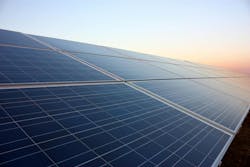Greenalia's Misae II Solar Project in Texas Gains $380M+ in Investment Backing
Two Japanese financial groups are partnering with a Spanish renewable energy developer to fund a utility-scale solar project in Texas which is also supported by two American corporate power purchase deals.
Mitsubishi UFJ Financial Group (MUFG) and Nomura Securities International (Nomura), have announced an agreement with Greenalia, a Spanish developer of renewable power projects, to provide a $295 million construction-to-term loan and $93 million letter of credit (LC) facility for Misae Solar Park II (Misae II) in Texas.
Misae II will cover 3,970 acres in Childress County for a 430 MW-DC / 331.6 MW-AC photovoltaic development. It is expected to achieve commercial operations by the third quarter this year.
"This transaction is a major step for Greenalia's U.S. expansion," said Manuel Garcia, CEO of Greenalia S.A. "With the help of MUFG and Nomura, we are on track to reach 1 GW of operational projects by 2026."
The project will benefit from two ERCOT West-settled power purchase agreements (PPAs) for 65 percent of its energy output and renewable energy credits. The remaining 35% of its energy will be sold into the merchant ERCOT market.
Misae II has executed a fixed-price PTC Transfer Agreement and a separate fixed-price agreement for 40 percent of the project's RECs.
Earlier this year, automotive components firm Aisin Corp. of American signed a 50-MW virtual PPA with Greenalia for output from the Misae II project. The renewable electricity generated from the renewable project offsets the company’s power consumption.
JTEKT Corp. also agreed to acquire nearly 150 MW in another virtual PPA deal with Greenalia for Misae II’s generation output. Under virtual PPAs, the customer usually does not connect directly into the renewable energy generated by the project, but its investment helps pay for construction and interconnection to help decarbonize the main grid.
